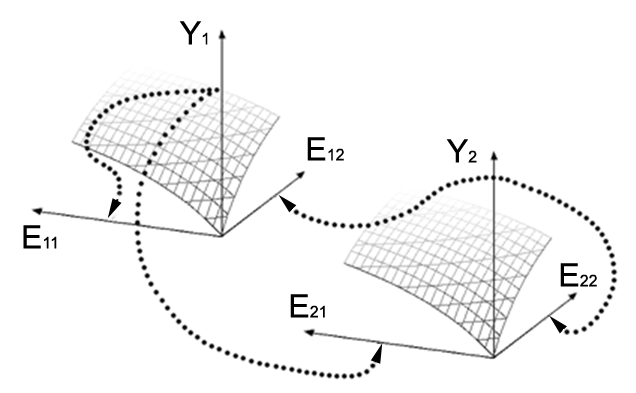While one might well think the notion of equilibrium has been referenced to a point of exhaustion in economics, there remain some points on which we find a continuing need for clarification. Two of the great personalities in the Vienna debates, Mises and Hayek, remained at odds over whether or not the economic system would remain at stable if the equilibrium prices were not also efficient. We pause here to argue Mises’ side of the case.
An input/output context provides for a closed representation of a physical equilibrium in which everything produced is just sufficient to replace everything used-up in the productive processes. In the figure below, an economy of just two sectors is portrayed by a mutual stasis with regard to their respective production tradeoffs. The output of each sector J YJ exactly replaces the employments EIJ of commodity J by the sectors I.

This figure should allow visualization of any number of ‘equilibria’ fulfilling the definition given above. If an operating point is chosen on one production function, the equilibrating point on the other production function resolves to a line across its surface of technical indifference. As the economic context is segmented into more and more sectors and commodities, complexity in the available patterns of stasis will increase geometrically.
There are those (e.g.: practitioners of Computable General Equilibrium) who are satisfied with a presumption that an economy will cease its adjustments at any physical equilibrium it happens to discover. This view is supported by our examination of general price equilibria, which demonstrated that any physically balanced input/output structure will determine a set of prices that balance money flows for any interest rate.
A more dynamic view would assert that economic adjustment is not concluded upon arrival of an input/output balance with equilibrium prices. The figure above demonstrates that even the most primitive I/O structure offers an unlimited array of balanced physical states; and any dynamic system having the freedom to choose among a continuum of equally desirable states will resonate among those states. To be determined in a dynamic context, the final economic state must be further defined so as to become unique.
Economics’ neoclassical mainstream unifies the equilibrium idea around its premise of general optimality. A general economic optimum GEO references the relative prices by which a given physical equilibrium is balanced in terms of the cash flows among all sectors. These prices then interact with the shape of each sector I’s production tradeoffs so as to equate the marginal value of every input J to it’s price PJ:

SFEcon’s use of the term ‘equilibrium’ follows this convention: it allows that stasis only exists for a uniquely desirable array of physical inputs and outputs; and presumes that the relation between general equilibrium prices and gradients of technical indifference brought together in the equation above is just sufficient to determine uniqueness.
The assertion of uniqueness of behalf of this formulation has general acceptance among orthodox economists; but heterodoxy asserts important exceptions, such as those highlighted by Varoufakis and Arnsperger (2006):
In General Equilibrium Theory its best practitioners state it quite categorically: convergence to some general equilibrium can only be proven in highly restrictive special cases. More generally, it is not just difficult to demonstrate that a system of theoretical markets will generate an equilibrium in each market, on the basis of rational acts on behalf of buyers and sellers; rather, it is impossible! (Mantel, 1973, and Sonnenschein, 1973,1974 are cited on the latter point.) 1Thus economics’ spectrum of opinion on its central notion of equilibrium contains many obviously irreconcilable differences, and therefore offers little prospect for unified advance. One way forward would be to create an objective demonstration of a matrix of exchanges approaching stasis under each of the regimes above. These models might then be compared in terms of realism in their components, fidelity of their behaviors to observation, etc.
SFEcon presumes (against admittedly strenuous findings to the contrary) to have objectified the
neoclassical concept of economic stasis for comparison with its heterodox alternatives, should these
ever be offered into evidence.
1 Christian Arnsperger and Yanis Varoufakis, post-autistic economics
review; Issue no. 38, 1 July 2006; article 1: What Is Neoclassical
Economics? The three axioms responsible for its theoretical oeuvre,
practical irrelevance and, thus, discursive power.
< http://www.paecon.net/PAEReview/issue38/ArnspergerVaroufakis38.htm >
A&V have greatly expanded their remarks in A Most Peculiar
Failure: On the dynamic mechanism by which the inescapable
theoretical failures of neoclassical economics reinforce its dominance.
< http://www.econ.uoa.gr/UA/files/1367110811.pdf >
As these sources are web-based, we are unable to locate the context
of our citations with more precision. Web-based sources are, however,
easily searched.